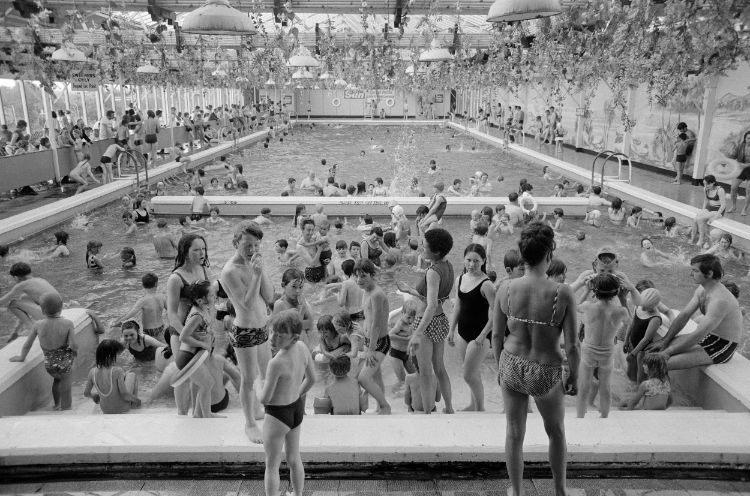Before Martin Parr captured Britain through his distinctive vividly coloured, wittily sarcastic, and intimately empathetic lens, the photographer experienced his native island purely through monochrome. At 20 years old, Parr was a Photography student at Manchester Polytechnic, eagerly constructing his artistic identity based on the documentary and street photographers Garry Winogrand, Robert Frank, and Bill Brandt. Tony Ray-Jones’ pathos-enriched photographs of 1960s England and its slowly depleting social landscape, for example, left a lasting impact on Parr. These photographers unite in their reasoned observations of the world around them, significant for their focus on ephemeral interactions and social idiosyncrasies. Within his early work, Parr augmented, experimented with, and perfected these aspects.
During the early 1970s, Parr worked as an official holiday photographer at Butlin’s by the Sea in Filey, North Yorkshire. Parr’s first role was a ‘black and white walkie’, shooting scenes across the holiday resort in monochrome. Attracted to the obscure whims of humanity, Parr’s work focused (and continues to do so) on personal tastes, social choices, and shifting attitudes. By the 1970s, Britain itself was experiencing a cultural revolution, driven by the newly evolving post-war Welfare State and the exponential growth of further education. As the UK leaned headfirst toward a great migration, Parr’s work followed suit, documenting the island on the cusp of fluctuating values and newfound experiences.
Untitled, from ‘Butlins by the Sea’ (1972), shot in black and white, both predates and lays the foundations for Parr’s colour-speckled, sunburnt series The Last Resort. Set in Butlins, a holiday resort famed for historically attracting bustles of working class families, this image acts as an authentic social commentary of the Northern experience during the 1970s.
A mass of people are shown collecting in the foreground of the image, dipping their toes into the swimming pool with an air of dizzying excitement ahead of their first ablution. The horde of bodies becomes slowly sparser as the pool’s depth increases, with the more seasoned swimmers braving deeper waters. Standing by the edge, individuals turn to face Parr and his camera, acknowledging their portraits being taken. Many, however, don’t appear to notice that their movements are being captured, and continue to frolic with careless abandon. Hanging from the ceiling are a series of uniform convex lamps, accompanied by an assemblage of decorative leaves and flowers. These adornments mirror the standing figures situated at the lower half of the composition, combining to become quasi-stalagmites and stalactites, populating the photograph with a stoic sturdiness. The image is dominated by the use of black and white, stripped from the rich and gaudy vibrancy more commonly associated with holidays. However, regardless of its monochrome simplicity, Parr’s photograph evokes the refreshing sensory experience of lounging by a swimming pool during the height of summer. When considering the image, it becomes bracingly easy to recall children’s elated shrieks, the sickly sour odour of chlorine, and the cracking splash of bodies making impact with water.
Untitled, from ‘Butlins by the Sea’ presents a view of the British public with equal measures of humour and bleakness. Potentially life saving signage such as ‘Swimmers Only Beyond this Point’ is juxtaposed against a garish advert celebrating the tabloid newspaper, The Sun. Utilising an empathetic approach, Parr has an uncanny knack of capturing the lived reality of countless Britons. From his early work with Butlins and beyond, Parr’s photography is able to reach deep within the nation’s consciousness
(By Eleanor Lerman)
